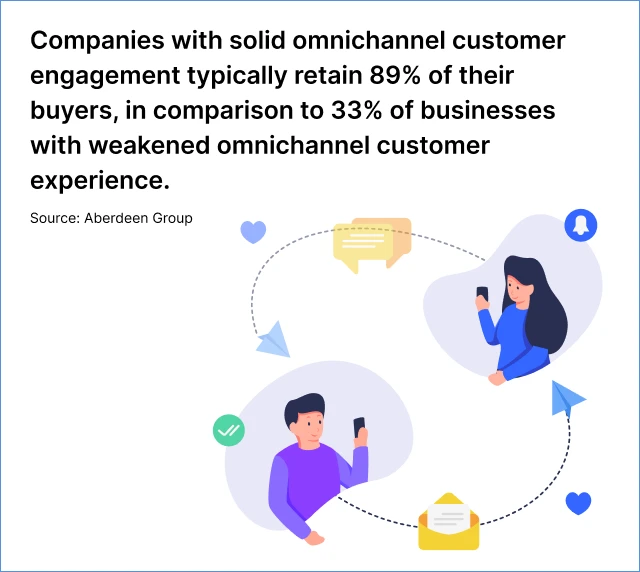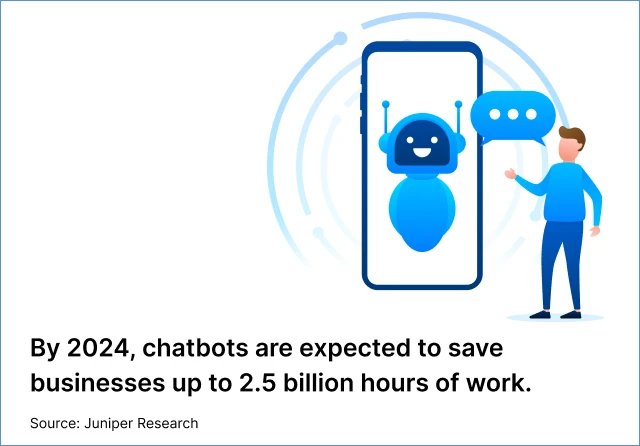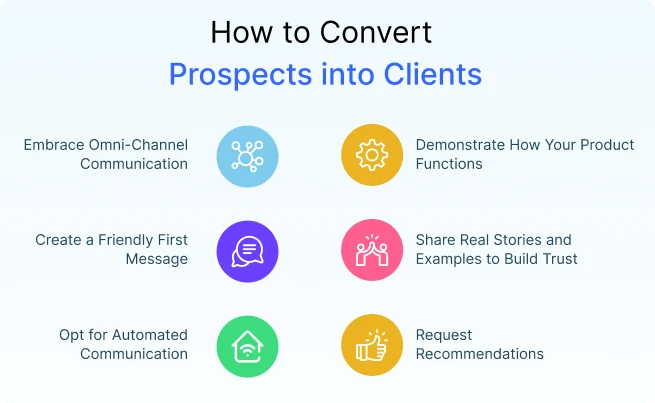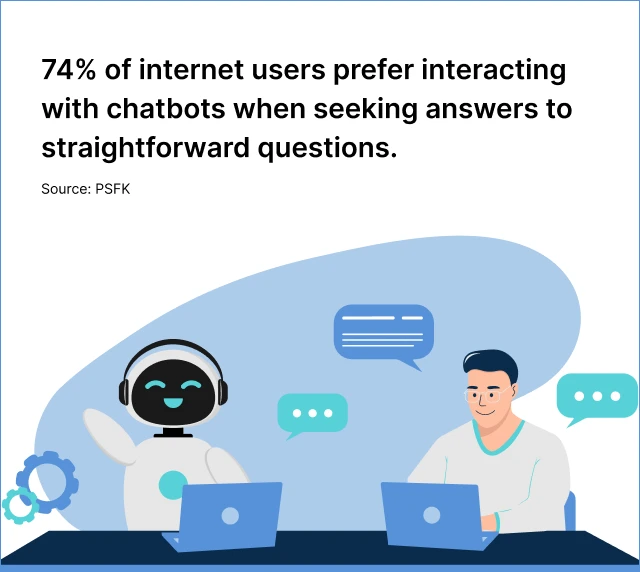What is Prospective Customer? Strategies, Tips & Examples
- March 18, 2024
- 17 mins read
- Listen

Table of Content
Understand who are your ‘PROSPECTIVE CUSTOMERS’ before you dive into developing your marketing and sales strategies. Sounds tricky? Well, it’s not that tough.
There has to be a system through which you will understand who are the prospective customers for your business. Also, all of your prospects may not behave the same with your brand. Some of them may behave indifferently, show less interest in your product offerings, or may not be the right segment to market to. There will be different techniques to handle them.
To help you identify the right ones for your business, today I will discuss what the prospective customers look like and how to turn them into your clients.
What is a Prospective Customer?
In simple terms, the prospect or prospective customer is a business or person who is interested in a service or product but has not paid for it yet.
The interest can be shown through different ways like:
- Signing up for a free trial, newsletter, or regular updates through emails
- Going through the company website
- Interested to know more about the product offerings.
In the early stage of a buyer’s journey, the prospect explores different brand options to choose from and decides if he wants to connect with a specific business or not. Remember, one thing! The prospects are not your customers yet but you have to identify them at the first stage itself to develop your marketing and sales strategies effectively.
For instance, Reebok aims to attract potential customers with higher incomes. They want to be seen as a premium brand, and their products often cost more than the average in the market. Their prospects are sports personnel and individuals who value a healthy, active lifestyle and can purchase their products.
Prospective Vs Potential Customers
‘Prospective’ and ‘Potential’ are terms often used interchangeably, but they carry slightly different nuances in certain contexts.
The basic difference between these two terms is- willingness. It means how likely the individual or business wants to be moved through your sales process. To distinguish a person or business as your potential customer, you must have set some parameters. The potential customer can buy your product but may not be interested in purchasing something from you at that moment. The term “potential” often implies a broader category, encompassing a larger audience that hasn’t necessarily been actively identified or engaged by the business yet.
On the other hand, a prospective customer has the intent to buy. For that reason, he will get in touch with your brand and initiate a conversation to know more. Such individuals are more likely to be converted into your clients.
Differences Between a Prospect and a Lead
Prospective customers and leads both terms refer to potential clients. They show interest in your company’s products, but there are five main differences:
- A prospective customer is closer to making a deal in the sales process than a lead.
- A prospective customer has fewer doubts or negativity about your product.
- A prospect is more loyal to your product offerings than a lead.
- Leads collect information, while prospects actively engage with a company through emails, live chat, phone calls, or meetings.
- In terms of communication, businesses handle multiple leads simultaneously, but with prospects, they focus on individual, one-on-one communication.
Basic Characteristics of Prospective Customers
How to identify the prospective customers? Well, they have specific characteristics by which we can differentiate them from the rest. Here are a few!
-
They Know about Their Pain Points
When faced with a challenge, our immediate instinct is to seek a way out promptly. In this situation, we become prospects for companies offering solutions to our specific problems. Convincing these prospects becomes relatively easier if you can demonstrate a clear understanding of their pain points and present an ideal solution.
For others, the process is more intricate. It requires diligent effort to educate them about their challenges and illustrate how your product or service is helpful. This process is lengthier but essential for building conviction and trust.
-
They Know You Have the Way-Out
Did you know that 62% of customers prefer to hear from companies about what they are offering and how the services can work to solve their issues? This means your sales team should know the product well to suggest a solution that fits what customers need. So arrange product training regularly.
As a business owner, you can’t fix every customer problem. So, remember that your product or service can be the solution to what a customer is facing.
-
They Show Interest
As the prospective customers are in search of solutions to their challenges, they are anyways interested in buying your products. It’s easier to crack the deals here. They may get in touch with your company over a phone call, live chat, visit your website, or connect on other social media platforms to learn more about your offerings.
-
They Engage with Your Marketing Activities
Understand one thing, the prospects are half-convinced to buy from you. Due to this, they will easily engage with your marketing activities. They may sign up for a free trial, or newsletters, fill in a form, and ask for more details to understand your offerings in a better way.
So, engage with each one of them and hear them out. Lastly, show them how your product works to solve their issues.
-
They Have the Ability to Buy Your Product
You might meet someone interested in your solution because they know there’s a problem you can fix. But, they might not have enough money to buy what you’re offering.
Did you know that 58% of customers prefer talking about the cost upfront? Surprisingly, only 23% of salespeople do this. To avoid wasting time on a sale that won’t work out, it’s smart for salespeople to bring up prices early. If the customer has a budget, then he could be a great potential customer.
-
They Trust Your Brand
Now, you have to work hard on this. Earning credibility and loyalty is important for your brand if you want to be in the long run. We all do business with companies whom we trust. To achieve this, keep working consistently on your brand through content marketing, customer reviews, and success stories. Plan how to encourage people to talk positively about your business, so you stay in the minds of potential customers.
How to Approach Your Potential Clients?
There are many potential customers out there for your brand but remember all of them are not the prospects.
About half of the potential customers whom businesses target end up not being a good match. In other words, companies spend a lot of resources on people who are not the right fit. To avoid wasting time and money, begin by figuring out which prospects could become your best customers. Here are some of the best methods to help you with that.
-
Examine Your Customer Demographics
You might already be aware that not every customer is equally important. According to Pareto’s rule, around 20% of your customers usually bring in about 80% of your profits. While newer calculations may vary a bit, the main idea remains the same: focusing on a smaller group of customers tends to bring in a bigger share of the profits.
So, understand what your existing customers experience with your product. Make a list of your good customers and find out the common factors among them. They must be coming from the same background, financial capabilities, preferences, or choices. So, when you will find out the prospective customers, look for these specific characteristics.
Also, you can talk to your customer support team and they handle thousands of new users every day. They can tell you about the common concern, what they are looking for in your service etc. All these together help you to make new strategies to attract new customers.
-
Establish an Online Footprint
Available online! This is one of the best ways to attract new prospective clients. Today’s tech-savvy users mostly rely on the web to do business. Even we also research on the net about a product, read reviews, and check out the website to get an idea about it before making the final decision.
Develop a user-friendly and visually appealing website that showcases your products or services. Include essential information such as your company’s story, offerings, contact details, and testimonials. Ensure your website is optimized for search engines to increase visibility. And finally create and maintain a strong presence on relevant social media platforms like Facebook, Instagram, and Twitter. Share valuable content, engage with your audience, and use it as a platform to showcase your expertise and build trust.
-
Recognize Key Decision-Makers
Prospect customers and decision markers can be the same individual or business or may be different. You have to understand this first. For example, you are the sales representative for a software company, and you want to approach a prospect, suppose XYZ Corporation, to sell your project management software. Here you might recognize key decision-makers because they are the ones who will pay for it. The employees of that company will be using your product but the management may decide whether to buy from you or not.
By this, you can tailor your approach and communication to effectively address the needs and concerns of those who have the authority to make purchasing decisions.
-
Attract Audiences from Competing Businesses
Discovering potential customers who already like your competitors’ products is a smart move. To do this, check out your competitors’ social media pages. Look at their feeds, posts, comments, and followers to find people interested in similar products. Next, try to reach out to those interested people.
Also, take a peek at the content your competitors use to promote their products and how the prospects are responding to it. Understanding what their customers like can help you figure out what features are valued, giving you improvement ideas for your product.
-
Provide Solutions, Beyond Mere Products
Remember that the prospective clients are searching for solutions to their problems. Approaching them with a focus on providing solutions beyond mere products is a strategic and customer-centric approach. Research your potential clients thoroughly to understand their business, industry, challenges, and goals. Identify specific pain points and challenges they may be facing that your products or services can address. Based on this info tailor your communication to address the specific needs of each potential client.
How to Convert Your Prospect Customers into Clients?
Nobody enjoys losing, especially when your plan to turn potential customers into actual sales doesn’t quite work out. But we all understand that when a strategy falls short, it’s a chance to learn, adjust, and improve.
It may sound easy, but we all know it’s harder in practice. So, here are some of the smart strategies for you to convert the prospects into real customers.
1. Embrace Omni-Channel Communication
The sales process works in a specific sequence that is: Attention-Interest-Desire-Action.
However, this doesn’t always happen in a fixed order. Customers might skip steps, check out other brands, change their minds, or visit a website through various channels. That’s why it’s important to connect all communication channels in one system.
Omnichannel is a way to bring together different ways of talking to customers into a single system. Here customers can connect with your brand on different channels like website and social media platforms. You can also maintain consistent messaging across all those channels and manage everything from a single place. It’s all about keeping things smooth and consistent for a better experience.
2. Create a Friendly First Message
Try to be personal in your communication while engaging with your prospective customers. A simple generic pitch is not going to work here. Regardless of how you contact them be it through phone calls, emails, or live chat, the message has to be personalized for every customer.
Here are some tips for you!
- Listen more and speak less.
- Hear patiently what exactly the problem is and share your solution after that.
- Don’t sound robotic, be kind, friendly, and understanding.
- Help them to deal with their problems, don’t force to buy your products.
3. Opt for Automated Communication
People crave immediate help! Often, when they visit a website, browse products, and show interest, they want quick information. To meet this need, offering chatbot and live chat support emerges as two excellent options. However, your customer support team might be occupied with complex tasks at times. This is where automated communication through chatbot becomes handy, automating various business operations, including customer support that too 24/7.
Modern AI chatbots can handle a multitude of business functions. For instance, they can assist in booking flight tickets online by accepting your request, displaying available flights, processing your payment, and ultimately confirming the booking. Chatbots also retain previous interactions, generate performance reports, and offer many other functionalities.
4. Demonstrate How Your Product Functions
When we’re interested in a product, we want to see how it functions before deciding to buy. Share all the cool things your product can do, like its smart features, pros, and opportunities. You can do this by creating a guide with text or video, making a presentation, user manual, or through one-to-one conversation.
The smartest choice is to give them a free trial. This lets them see if your product is what they’re looking for, and it also gives you a reason to talk to them again after the trial is over.
5. Share Real Stories and Examples to Build Trust
Nearly 88% of people trust reviews from other users almost as much as they trust recommendations from friends. When you combine storytelling with social proof, it becomes even better. Most of us when buying something online, tend to check customer reviews and testimonials to know what others are saying about that specific product. We also check customer ratings.
Showing authentic experiences and success stories can help build trust and credibility, making your prospects more likely to make a purchase.
6. Request Recommendations
How to get referrals? It’s simple! After someone becomes your customer, just ask if they know others who might like what you offer. If they’re not sure or hesitate, wait until they’ve enjoyed your product or service. Once you know they’re happy, ask again. And to make it even better, you can reward them, like a discount, for referring others to you.
Pro Tips:
- Always reward successful referrals.
- Tailor your referral requests based on your relationship with each customer.
- Once a customer gives you a referral, don’t forget to update him about the progress.
- Show appreciation for their referrals, whether you have got new customers or not.
- Simplify the referral process for your customers.
- Don’t rely on just one method to ask for referrals. Utilize email, social media, or even in-person conversations to maximize your chances.
Attracting the Prospective Customers: Best Real-Life Examples
Now, let’s explore examples of what a potential customer might look like in various industries.
eCommerce
Here, a prospective client is someone who has browsed the online store, liked some of the products, and added those to his cart but has not completed the payment yet. He may wishlist some products or sign up for regular updates as well.
How to approach him?
- Through a proactive chatbot, you can get in touch with him and ask if he needs some help to complete the purchase.
- Through email and push notifications or SMS you can remind him about his abandoned cart.
- You can offer him some small discounts.
Real Estate
In real estate, a prospective customer is someone who asked about a house or apartment for sale or rent, visited some of the sites, or browsed a real estate website to get regular alerts about available properties. Essentially, it’s anyone who is looking into the possibility of becoming a new homeowner or tenant.
How to approach them?
- First, personally get in touch with him through live chat, email, or phone call and fix up a one-on-one meeting.
- AI chatbot for real estate is also a good option for proactive assistance.
- Listen carefully to his requirements.
- Ask questions about his preferences, idea property, and budget.
- Demonstrate your knowledge of the local real estate market, trends, and neighborhoods.
- Share insights about property values, potential investment opportunities, and any upcoming developments in the area.
- Share testimonials, case studies, and success stories about your real estate company to build trust.
- Educate your potential customers about the real estate process, from property searches and negotiations to closing the deal.
- Offer informative resources, such as market reports, guides, or blog posts, to help them make informed decisions.
- Tailor your communication style and content to match the preferences of each client.
B2B Business
Here the prospective customer will be a company that gets in touch with a service provider to know more about its services, benefits, and pricing but has not signed the contract yet. Acquiring and maintaining business-to-business (B2B) customers involves a distinct set of strategies compared to business-to-consumer (B2C) interactions.
The service provider companies need to check all their competitors and understand what extra they are offering to stay ahead in the long run. As the competition is huge here, you have to offer something extra to attract new customers and retain them.
Pro Tips:
- Before approaching a prospective B2B customer, thoroughly research and understand their specific business needs and challenges.
- Tailor your communication to highlight how your solution can address their unique pain points and contribute to their business goals.
- Engage in networking events, industry conferences, and other platforms where you can connect with decision-makers and influencers within target organizations.
- Offer customized solutions that align with the unique requirements of each business prospect.
- Showcase how your product or service can provide value, enhance efficiency, or solve specific problems within their operations.
Travel and Tourism
Prospect is an individual or a group of people who want to book flights, accommodation tour packages, or other travel-related services. They visit different websites that offer travel-related services, ask for quotes, or try to book flight or train tickets. Identifying and understanding these potential customers is crucial for travel businesses to tailor their offerings and marketing strategies effectively.
How to approach such clients?
- Reach them proactively on the website itself through live chat or chatbot to offer instant assistance.
- You can also help them book flights through screen share or over phone calls.
- Talk to them to understand their preferences and offer customized travel packages.
- Ensure that your communication is clear, transparent, and responsive.
- Send newsletters, updates, and exclusive offers to keep your audience engaged.
How REVE Chat Can Help You Out?
REVE Chat serves as a comprehensive omnichannel customer engagement platform, enabling instant assistance on various platforms such as websites, mobile apps, and popular social media platforms including Facebook, Instagram, Telegram, Viber, and WhatsApp.
Seeking to connect with potential customers on their preferred channels? REVE Chat is the solution you need. It facilitates consistent messaging across all platforms while allowing you to manage interactions seamlessly from a centralized location.
Consider an eCommerce scenario: With REVE Chat, you can monitor real-time website visitors and proactively engage with them, offering instant assistance and even preventing potential exits from your site.
Moreover, REVE Chat features an advanced AI chatbot designed to automate customer support and other business operations. This AI chatbot can efficiently handle multiple customer inquiries simultaneously, assisting 24/7, even during peak times when support agents are occupied with complex tasks.
Experience it firsthand with REVE Chat’s 14-day FREE TRIAL, allowing you to explore and test all its distinctive features. Don’t miss out – SIGN UP today!








